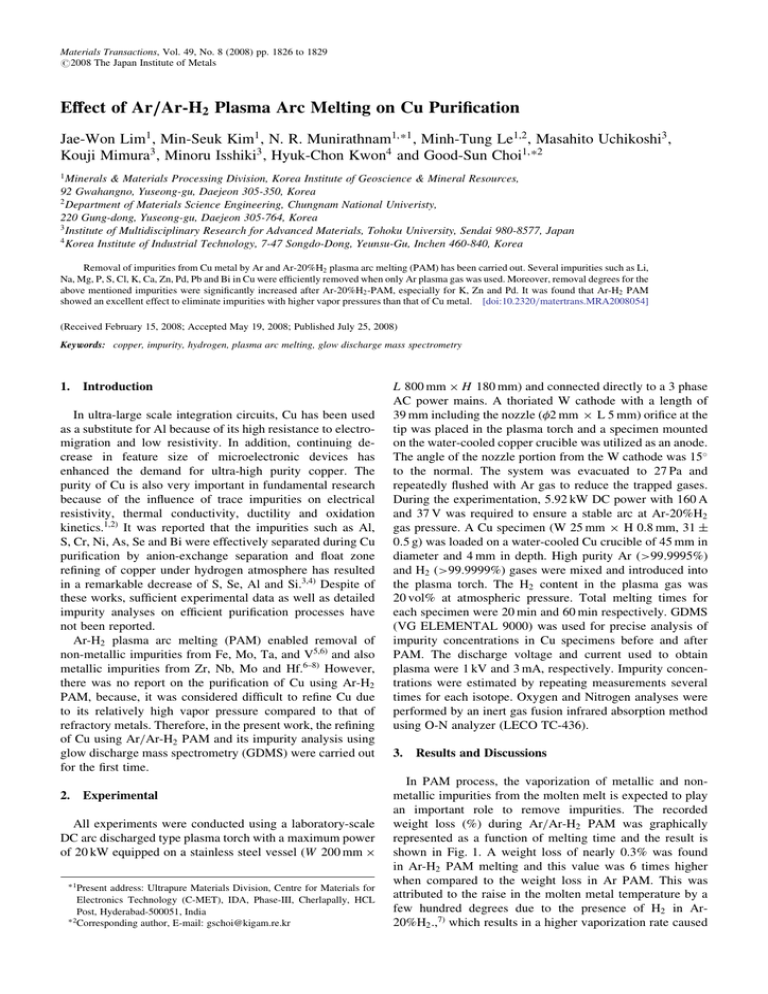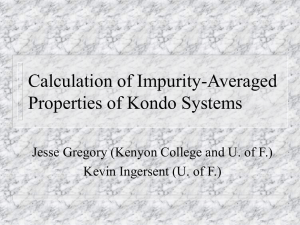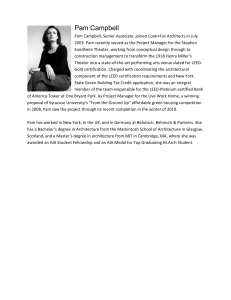Effect of Ar/Ar-H_{2} Plasma Arc Melting on Cu Purification
advertisement

Materials Transactions, Vol. 49, No. 8 (2008) pp. 1826 to 1829 #2008 The Japan Institute of Metals Effect of Ar/Ar-H2 Plasma Arc Melting on Cu Purification Jae-Won Lim1 , Min-Seuk Kim1 , N. R. Munirathnam1; *1 , Minh-Tung Le1;2 , Masahito Uchikoshi3 , Kouji Mimura3 , Minoru Isshiki3 , Hyuk-Chon Kwon4 and Good-Sun Choi1; *2 1 Minerals & Materials Processing Division, Korea Institute of Geoscience & Mineral Resources, 92 Gwahangno, Yuseong-gu, Daejeon 305-350, Korea 2 Department of Materials Science Engineering, Chungnam National Univeristy, 220 Gung-dong, Yuseong-gu, Daejeon 305-764, Korea 3 Institute of Multidisciplinary Research for Advanced Materials, Tohoku University, Sendai 980-8577, Japan 4 Korea Institute of Industrial Technology, 7-47 Songdo-Dong, Yeunsu-Gu, Inchen 460-840, Korea Removal of impurities from Cu metal by Ar and Ar-20%H2 plasma arc melting (PAM) has been carried out. Several impurities such as Li, Na, Mg, P, S, Cl, K, Ca, Zn, Pd, Pb and Bi in Cu were efficiently removed when only Ar plasma gas was used. Moreover, removal degrees for the above mentioned impurities were significantly increased after Ar-20%H2 -PAM, especially for K, Zn and Pd. It was found that Ar-H2 PAM showed an excellent effect to eliminate impurities with higher vapor pressures than that of Cu metal. [doi:10.2320/matertrans.MRA2008054] (Received February 15, 2008; Accepted May 19, 2008; Published July 25, 2008) Keywords: copper, impurity, hydrogen, plasma arc melting, glow discharge mass spectrometry 1. Introduction In ultra-large scale integration circuits, Cu has been used as a substitute for Al because of its high resistance to electromigration and low resistivity. In addition, continuing decrease in feature size of microelectronic devices has enhanced the demand for ultra-high purity copper. The purity of Cu is also very important in fundamental research because of the influence of trace impurities on electrical resistivity, thermal conductivity, ductility and oxidation kinetics.1,2) It was reported that the impurities such as Al, S, Cr, Ni, As, Se and Bi were effectively separated during Cu purification by anion-exchange separation and float zone refining of copper under hydrogen atmosphere has resulted in a remarkable decrease of S, Se, Al and Si.3,4) Despite of these works, sufficient experimental data as well as detailed impurity analyses on efficient purification processes have not been reported. Ar-H2 plasma arc melting (PAM) enabled removal of non-metallic impurities from Fe, Mo, Ta, and V5,6) and also metallic impurities from Zr, Nb, Mo and Hf.6–8) However, there was no report on the purification of Cu using Ar-H2 PAM, because, it was considered difficult to refine Cu due to its relatively high vapor pressure compared to that of refractory metals. Therefore, in the present work, the refining of Cu using Ar/Ar-H2 PAM and its impurity analysis using glow discharge mass spectrometry (GDMS) were carried out for the first time. 2. Experimental All experiments were conducted using a laboratory-scale DC arc discharged type plasma torch with a maximum power of 20 kW equipped on a stainless steel vessel (W 200 mm *1Present address: Ultrapure Materials Division, Centre for Materials for Electronics Technology (C-MET), IDA, Phase-III, Cherlapally, HCL Post, Hyderabad-500051, India *2Corresponding author, E-mail: gschoi@kigam.re.kr L 800 mm H 180 mm) and connected directly to a 3 phase AC power mains. A thoriated W cathode with a length of 39 mm including the nozzle (2 mm L 5 mm) orifice at the tip was placed in the plasma torch and a specimen mounted on the water-cooled copper crucible was utilized as an anode. The angle of the nozzle portion from the W cathode was 15 to the normal. The system was evacuated to 27 Pa and repeatedly flushed with Ar gas to reduce the trapped gases. During the experimentation, 5.92 kW DC power with 160 A and 37 V was required to ensure a stable arc at Ar-20%H2 gas pressure. A Cu specimen (W 25 mm H 0.8 mm, 31 0:5 g) was loaded on a water-cooled Cu crucible of 45 mm in diameter and 4 mm in depth. High purity Ar (>99:9995%) and H2 (>99:9999%) gases were mixed and introduced into the plasma torch. The H2 content in the plasma gas was 20 vol% at atmospheric pressure. Total melting times for each specimen were 20 min and 60 min respectively. GDMS (VG ELEMENTAL 9000) was used for precise analysis of impurity concentrations in Cu specimens before and after PAM. The discharge voltage and current used to obtain plasma were 1 kV and 3 mA, respectively. Impurity concentrations were estimated by repeating measurements several times for each isotope. Oxygen and Nitrogen analyses were performed by an inert gas fusion infrared absorption method using O-N analyzer (LECO TC-436). 3. Results and Discussions In PAM process, the vaporization of metallic and nonmetallic impurities from the molten melt is expected to play an important role to remove impurities. The recorded weight loss (%) during Ar/Ar-H2 PAM was graphically represented as a function of melting time and the result is shown in Fig. 1. A weight loss of nearly 0.3% was found in Ar-H2 PAM melting and this value was 6 times higher when compared to the weight loss in Ar PAM. This was attributed to the raise in the molten metal temperature by a few hundred degrees due to the presence of H2 in Ar20%H2 .,7) which results in a higher vaporization rate caused Effect of Ar/Ar-H2 Plasma Arc Melting on Cu Purification 106 0.5 Ar Ar -20% H2 105 Vapor Pressure (Pa) 0.4 Weight Loss (%) 1827 0.3 0.2 0.1 K Na Zn Mg Ca Pb Mn Cu Al Cr Fe 104 Si V 103 102 10 Ni, Co 1 M. P. 100 10-1 W 10-2 0.0 0 10 20 30 40 50 60 70 Melting Time, t/min Fig. 1 Weight loss of Cu metal as a function of melting time. by the temperature increase of the molten metal. The efforts to measure the surface temperature of the molten copper has proved unsuccessful. It was impossible to measure directly the surface temperature by two color pyrometer because of a high temperature plasma flame on the surface of the molten metal. Therefore, an alternative method to measure indirectly the specimen temperature using a melting point technique was adopted. As preliminary experiments, arc power values required for melting source of refractory metals and their alloys were determined and the relation between the arc powers and their melting points was used as a reference curve to estimate the surface temperature of specimens. These experiments showed that the metal temperature increased with H2 content in the plasma gas at the atmospheric pressure under a same arc power. For example, at 5.92 kW of arc power, the temperature difference (T) of Ar plasma (TAr ) and Ar-20% hydrogen plasma (TAr+20%H2 ) was nearly 445 5 K, respectively. On the other hand, we could unsuccessfully measure the precise temperature in Ar and Ar-H2 plasma arc melting due to rapid heat losses by high thermal conductivity of Cu. Figure 2 shows the vapor pressure of main impurities and Cu metal as a function of temperature based on the thermochemical equations.9) The impurities with higher vapor pressures than that of Cu were expected to be eliminated easily from Cu metal. On the other hand, the impurities such as Ni, Co, Cr, Fe were not separated due to closer and lower vapor pressures than that of Cu. In addition, Al and Si impurities in Cu molten metal cannot be separated easily due to the formation of Al2 O3 and SiO2 inclusions in the starting material itself.4) GDMS analytical results of the Cu metal purified by Ar/ Ar-H2 PAM for 20 and 60 min are shown in Table 1. Other elements in the periodic table except impurities given in table were not detected in the Cu matrix. The results indicate that over all purity of the Cu starting was above 99.9962%. On the same terms, this purity was raised up to 99.9979% after Ar-20%H2 PAM. A slight increase in oxygen concentration during PAM in Ar for 60 min was due to some unknown contamination during sample treatment. For the description of experimental data, the removal degree, RD(%), of each impurity is defined by eq. (1). 10-3 500 1000 1500 2000 2500 3000 3500 Temperature, T / K Fig. 2 Vapor pressure of main impurities and Cu metal as a function of temperature. RDð%Þ ¼ 100ðCi Cf Þ=Ci ð1Þ where Ci and Cf , are the initial and final concentrations, respectively. Since the Li and Na impurity concentrations in Cu specimens before and after melting were close to its respective detection limit of GDMS analysis, it was difficult to clarify its behavior and then these results were omitted from the calculation of removal degree. No significant removal of gaseous (O, N) and gas-forming (C) impurities were found in Ar/Ar-H2 PAM. Among halogen impurities, Cl was removed very efficiently, whereas the initial concentration of F impurity was so small that we could not find its behavior by Ar/Ar-H2 PAM. On the other hand, Se and As were not affected in both Ar/Ar-H2 PAM. Non-metals separation was limited to P and S. Zhu et al. ascribed that S in Cu could be removed by the formation of H2 S as well as the vaporization of S.4) In metallic impurities, removal of Zn, Pb, Bi Ca and Mg in Cu were significantly higher. Among transition metals, Pd removal was relatively high. The others like Ni, Co, Cr and Fe have no significant effect in Ar/Ar-H2 PAM. However, W impurity element has slightly increased from 0.001 ppm to 0.11 and 0.14 ppm after Ar/Ar-H2 PAM. In the previous work,10) we have found that W was contaminated from the W-2%ThO2 cathode used as a plasma torch and it is explained that this contamination could be suppressed by efficient cooling system in the plasma torch. Table 2 shows the RD(%) of each impurity from Cu during PAM with Ar (RDAr ) and Ar-H2 (RDAr+20%H2 ) gases and the difference in the removal degree, RD ¼ RDAr+20%H2 ð%Þ RDAr ð%Þ. We classified according to the RD(%) and the difference in the removal degree of each impurity element from Cu during PAM. Figure 3 shows the RD(%) relation of each impurity removed from Cu after Ar/Ar-H2 PAM. For Ar-PAM, Cl, Ca, Bi and S show a high RD(%), where as the RD(%) of Zn, Pb and Mg was remarkably high for Ar-H2 PAM. The figure clearly indicated, in general, a higher removal efficiency of impurities by Ar-H2 PAM when compared to Ar PAM. This means that there was a certain driving force chemically induced by activated hydrogen atoms during Ar-H2 PAM. Tanaka et al.11) predicted that the cause for the arc constriction in plasma melting process is not by increased thermal conductivity but by increased 1828 J.-W. Lim et al. Table 1 Impurity concentrations (mass ppm) in the Cu metal refined by Ar/Ar-H2 PAM. Starting material Ar (20 min) Ar (60 min) Ar+20%H2 (20 min) Ar+20%H2 (60 min) Li 0.002 <0:001 <0:001 <0:001 <0:001 C N 1.34 1.4 1.25 1.7 1.33 1.7 1.27 1.0 1.20 1.2 Impurity O 15.0 F 15.3 33.5 11.4 6.8 0.003 0.003 0.003 0.003 0.002 Na 0.002 <0:001 <0:001 <0:001 <0:001 Mg 0.08 0.04 0.02 0.004 0.002 Al 0.24 0.23 0.24 0.28 0.26 Si 0.31 0.30 0.28 0.24 0.22 P S 4.28 5.22 3.55 3.41 2.95 1.25 3.68 1.76 2.35 0.33 0.005 Cl 0.19 0.05 0.03 0.03 K 0.12 0.06 0.07 0.01 0.005 Ca 0.03 0.01 0.005 0.002 0.002 Cr 0.008 0.008 0.008 0.007 0.008 Mn 1.25 1.11 1.09 1.07 1.08 Fe 0.86 0.84 0.83 0.85 0.85 Ni Co 0.67 0.002 0.68 0.004 0.67 0.002 0.66 0.002 0.66 0.002 Zn 0.19 0.13 0.07 0.005 0.003 As 0.16 0.16 0.15 0.17 0.16 Se 0.07 0.07 0.06 0.07 0.07 Pd 0.02 0.008 0.005 0.005 0.006 Ag 5.19 5.20 5.01 5.21 5.04 Sn 0.02 0.02 0.02 0.03 0.02 Sb W 0.11 0.001 0.10 0.06 0.11 0.11 0.10 0.12 0.11 0.14 Pb 0.84 0.42 0.18 0.20 0.02 Bi 0.01 0.005 0.002 <0:001 <0:001 Purity (mass%) 99.9962% 99.9965% 99.9950% 99.9972% 99.9979% Purity (mass%) (except C,N,O) 99.9980% 99.9984% 99.9987% 99.9985% 99.9989% Table 2 RD(%) of each impurity from Cu during PAM with Ar (RDAr ) and Ar-H2 (RDAr+20%H2 ) gases and the difference in the removal degree, RD ¼ RDAr+20%H2 ð%Þ RDAr ð%Þ. Impurity Mg RD(Ar) (%) 75 Impurity RD(Ar+20%H2 ) (%) Impurity Difference in RD (%), RD ¼ RD(Ar+20%H2 ) RD(Ar) Mg 97.5 Mg P 31.1 P 45.1 P 14 S Cl 76.1 84.2 S Cl 93.7 97.4 S Cl 17.6 13.2 K 50 K 95.8 K 45.8 Ca 83.3 Ca 93.3 Ca 10 Zn 63.2 Zn 98.4 Zn 35 Pd 75 Pd 70 Pd 5 Pb 78.6 Pb 97.6 Pb 19 Bi 80 Bi 90 Bi 10 specific heat (Cp ) and thus enthalpy (H). However, when 10% of hydrogen gas was introduced into Ar as an additive gas, there was an increase in thermal conductivity of a factor of 10 at 3000 K. This increased thermal conductivity causes a 22.5 cooling of the outer edge of the arc and thus a reduced arc cross-section followed by increased magnetic pinch pressure and increased axial plasma flow and thus the enhanced voltage. This voltage enhancement caused by the addition of Effect of Ar/Ar-H2 Plasma Arc Melting on Cu Purification 50 140 Ar 40 120 ∆ RD 100 ∆ RD (%) 30 80 20 60 10 40 0 20 -10 Removal Degree, RD (%) Ar+20%H2 0 Mg P S Cl K Ca Zn Pd Pb Bi Impurities in Cu Fig. 3 Comparison between RD(%) of main impurities in the Cu metal refined using Ar-PAM and Ar-H2 PAM. 10% hydrogen gas probably due to the large maximum in thermal conductivity of hydrogen at the low temperatures when hydrogen molecules dissociate in to atoms. In addition to the enhanced removal efficiency of Mg, P, S, Cl, K, Ca, Zn, Pb and Bi impurities in Cu, the removal efficiency of gaseous impurities like oxygen, carbon and nitrogen was higher when 20% hydrogen gas was introduced in to Ar. This enhancement of RD(%) was attributed to the increase of metal vapor transfer from a melt surface to gas phase by activated hydrogen atoms as well as the increase in temperature of the molten metal due to the higher thermal conductivity of hydrogen.10,12) 4. Conclusions The refining effect of Ar/Ar-20%H2 PAM for Cu metal and purity evaluation using GDMS were carried out. Excellent removal degree, RD (>90%) for the impurities like Zn, Pb, Mg, Cl, K, S, Ca and Bi in Cu was found using Ar-H2 PAM. The impurities like K, Zn and Pd in Cu were found to have higher RD(%) in Ar-H2 PAM compared to Ar-PAM. For Ar-PAM, Cl, Ca, Bi and S impurities show the high RD(%), whereas the RD(%) of Zn, Pb and Mg was remarkably high for Ar-H2 PAM. In addition to the enhanced 1829 removal efficiency of Mg, P, S, Cl, K, Ca, Zn, Pb and Bi impurities in Cu, the removal efficiency of gaseous impurities like oxygen, carbon and nitrogen was higher when 20% hydrogen gas was introduced in to Ar-PAM. The purity of copper increased from 99.9962% to 99.9979(%) after Ar-H2 PAM due to high RD(%) of impurities with higher vapor pressure than that of Cu metal. Acknowledgement This work was supported by a grant from the fundamental R&D program for Core Technology of Materials funded by the Ministry of Commerce, Industry and Energy, Republic of Korea. One of the authors, Dr. N. R. Munirathnam thanks Brain-Pool program of Korean Federation of Science and Technology for the financial support as visiting researcher at KIGAM. REFERENCES 1) S. P. Murarka, R. J. Gutmann, A. E. Kaloyeros and W. A. Lanford: Thin Solid Films 17 (1993) 257–266. 2) C. Cagran, B. Wilthan and G. Pottlacher: Thermochim. Acta 445 (2006) 104–110. 3) M. Uchikoshi, T. Kekesi, Y. Ishikawa, K. Mimura and M. Isshiki: Mater. Trans. 38 (1997) 1083–1088. 4) Y. Zhu, K. Mimura, Y. Ishikawa and M. Isshiki: Mater. Trans. 43 (2002) 2802–2807. 5) K. Kaneko, N. Sano and Y. Matsushita: J. Iron Steel Inst. Jpn. 62 (1976) 43–52. 6) K. Mimura and M. Nanojo: Proc. 8th Int. Symp. Plasma Chem., (IUPAC, Tokyo, 1987) pp. 886–1891. 7) K. Mimura, S. W. Lee and M. Isshiki: J. Alloys Compd. 221 (1995) 267–273. 8) J. W. Bae, J.-W. Lim, K. Mimura and M. Isshiki: Mater. Lett. 60 (2006) 2604–2605. 9) O. Knache, O. Kubaschewski and K. Hesselmann: Thermochemical Properties of Inorganic Substances, (Springer-Verlag, New York, 1991) pp. 2370. 10) J.-W. Lim, K. Mimura and M. Isshiki: J. Mater. Sci. 40 (2005) 4109–4111. 11) M. Tanaka and J. J. Lowke: J. Phys. D: Appl. Phys. 40 (2007) R1–R23. 12) D. Elanski, J.-W. Lim, K. Mimura and M. Isshiki: J. Alloys Compd. 413 (2006) 251–258.


